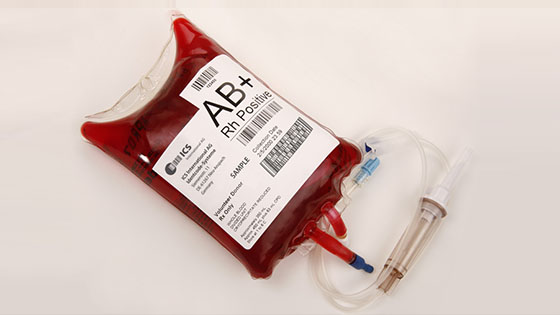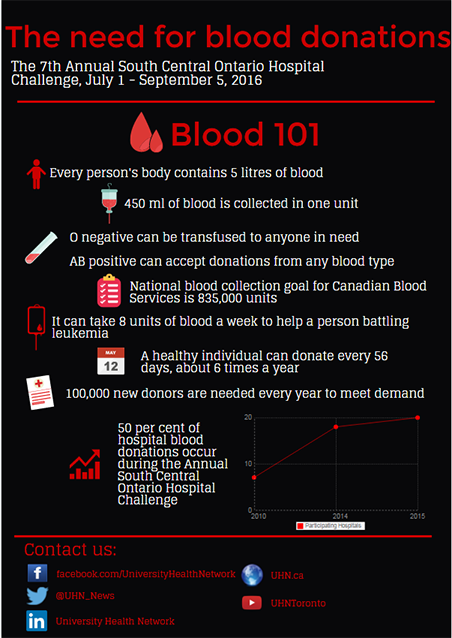 UHN hospitals use up to 40,000 units of blood every year. The Canadian Blood Services’ (CBS) Annual South Central Ontario Hospital Challenge now underway is designed to encourage employees to donate. (Photo: Flickr)
UHN hospitals use up to 40,000 units of blood every year. The Canadian Blood Services’ (CBS) Annual South Central Ontario Hospital Challenge now underway is designed to encourage employees to donate. (Photo: Flickr)
UHN hospitals are participating in Canadian Blood Services' (CBS) Annual South Central Ontario Hospital Challenge until Sept. 5.
On average, UHN hospitals use up to 40,000 units of blood every year. The hospital challenge is designed to encourage employees to donate, helping CBS to reach their annual national average goal of 835,000 units of blood.
Dr. Jacob Pendergrast, a hematologist at Toronto General Hospital, spoke with UHN News to discuss what patients, family members and staff should know about donating blood.
Regular blood donors tend to be healthier people overall.
In the past, there have been reports of a number of health benefits associated with donating blood. Donating blood can reduce both iron levels and blood viscosity (meaning your blood gets thinner), both of which are linked to a decreased risk of cancer, diabetes and cardiovascular disease.
However, Dr. Pendergrast says it is more likely that regular blood donors tend to be healthier overall than the rest of the population. Researchers have looked at other factors affecting overall health such as diet, exercise and how frequently donors visit their doctors, and found that for the most part donors identify as healthier people.
Blood shortages happen more frequently around holidays.
Summer time means summer vacations, but those weekends at the cottage can have a severe impact on the amount of blood available to patients who need it.
 The facts and statistics on blood donations and blood need in Canada, featured in the above-captioned infographic, highlight the importance of consistent blood donations.(Photo: UHN)
The facts and statistics on blood donations and blood need in Canada, featured in the above-captioned infographic, highlight the importance of consistent blood donations.(Photo: UHN)
×![]()
To find out if you are eligible to donate, visit Canadian Blood Services
website or call at
1 888 2 Donate.
"You get one long weekend where a lot of people are out of town, typically around Labour Day, and suddenly the entire country is short," says Dr. Pendergrast.
"It's not the only thing that can cause a shortage, but we're definitely vulnerable to the number of available donors."
Certain blood products expire faster than others.
While these seasonal shortages affect all blood products, platelet availability is the most vulnerable, because platelets must be transfused within five days of donation.
"The platelets are pretty much hand to mouth. That's the one we're always calling shortages on," says Dr. Pendergrast.
He says other blood products, like red blood cells and plasma, are good for a much longer period of time, so it's rare for Canadian Blood Services to run out entirely. Red blood cells are good for 42 days, and plasma for up to a year.
You can donate platelets and plasma more frequently than red blood cells.
The amount of time people are required to wait between blood donations also varies between blood products. According to Canadian Blood Services, a donor can donate red blood cells every 56 days. Plasma can be donated every seven days, and platelets every 14 days.
To separate platelets and plasma from the blood, Dr. Pendergrast says they take all the blood out, spin it down to separate all the platelets or plasma, and then return it to the body.
Though people do lose a small amount of blood in the process, he says platelet and plasma donations have less of an impact on overall iron levels and can therefore be done more frequently.
-
The population of eligible blood donors is growing.
Dr. Pendergrast says one of the most common reasons people don't donate blood is that they have been told in the past they're not eligible.
But the rules to determine eligibility have changed recently, opening the doors for new donors who might not have been eligible in the past. He says one significant change is that people from many countries in West Central Africa who have been in Canada for at least a year can now donate.
Dr. Pendergrast says this is especially important for patients with sickle-cell disease, who may require 10 to 20 units of blood every month. The best donor matches for these patients are those of a similar ethnic background, and a large proportion of patients are of African descent.
"The blood they require is very specialized, and we need to very carefully select the blood up front so it's well-matched. It's almost like a teeny tiny organ transplant," he says.
Want to participate in the hospital challenge? Here's how:
Register at
www.blood.ca/en/blood/how-do-i-join-team by clicking "Register as a Member Online." Enter your personal information and your employing hospital's Partner For Life (PFL) ID number and then click "Finish." The UHN hospitals' PFL ID numbers are:
- Princess Margaret – PRIN010907
- Toronto General – UNIV011216
- Toronto Western – TORO011007
- Toronto Rehab – TORO013276
Call 1 888 2 DONATE or visit www.blood.ca and make an appointment at your nearest blood clinic.
The most preferred clinic for donation by most hospitals is the 67 College Street Canadian Blood Services clinic
